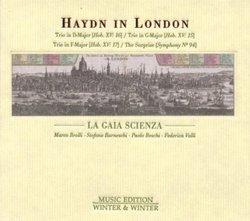| All Artists: Haydn, La Gaia Scienza, Brolli, Barneschi Title: Haydn in London Members Wishing: 0 Total Copies: 0 Label: Winter & Winter Original Release Date: 1/1/2009 Re-Release Date: 9/8/2009 Genre: Classical Styles: Chamber Music, Historical Periods, Classical (c.1770-1830) Number of Discs: 1 SwapaCD Credits: 1 UPC: 025091015627 |
Search - Haydn, La Gaia Scienza, Brolli :: Haydn in London
CD Details |
CD ReviewsWhich came First. the Singer or the Song? Giordano Bruno | Wherever I am, I am. | 08/01/2010 (5 out of 5 stars) "If that riddle seems too self-evident, let me ask in another way? Which came first, the piano or piano music? And tightening the focus, which came first, the fortepiano or the music composed by Joseph Haydn (1732-1809) specifically for the fortepiano (aka Hammerklavier)? And does anyone suppose that Haydn was such a fumbler that he composed music which couldn't be played on the instrument he knew, or which didn't make full use of the unique musical attributes of that instrument?
The first experimental fortepianos were developed in Italy at the beginning of the 18th Century, but they didn't come into favor until the middle of Joseph Haydn's composing career. They were received, not as a substitute for the harpsichord, but as a distinct instrument. Various composers, including several of the Bachs, wrote music precisely intended for harpsichord and fortepiano in ensemble. The fortepiano has leather-covered hammers and thin, harpsichord-like strings. It has a much lighter case construction than the modern piano and, except for later examples of the early nineteenth century, it has no metal frame or bracing. The action and hammers are lighter, giving rise to a much lighter touch, which in good fortepianos is also very responsive. There is considerable difference in the timbres of the lower and upper octaves of the fortepiano. The most salient difference is the "die" time of an unstopped struck note; in effect, because the note will die quickly, damping is not as necessary as on a grand piano, and the passages played on a fortepiano will be more transparent and less 'complicated' by prolonged resonances. The strings are not crossed on a fortepiano, as they are on a grand piano; thus there are fewer 'sympathetic' resonances and overtones. In other words, the fortepiano sounds very different from the modern piano, and should be considered an instrument in its own right, and not merely a stage in the development of the concert grand. Federica Valli's fortepiano certainly sounds different in this recording of three trios by Haydn for fortepiano, flute, and cello plus a trio 'reduction of Haydn's Symphony #94 for a fortepiano quartet, done by a contemporary. Valli makes her keyboard sparkle and cavort through this deliciously jolly music, with the cello chiefly reinforcing the fortepiano's lute-like bass notes. The traverso flute played by Marco Brolli is a copy of a wooden instrument made by Carl August Grenser of Dresden, circa 1790. With fewer keys than the modern 'silver' flute, it's probably fair to call it a transitional instrument, one that tunes more easily in some keys than in others, but the chief difference one hears on this recording is not in the construction of the flute but in the technique of its performer. In keeping with the practices of Haydn's musical milieu, Brolli entirely eschews vibrato on his flute and systematically exploits the plangent timbres that result from cross-fingerings to add 'affect' as well as virtuosity to the passages he gallantly tosses to and fro with the fortepiano. For people of Haydn's world, the sound of the flute invariably suggesting "pastoral simplicity", a perception lost to modern listeners but recaptured by Brolli in his interpretation of these trios. If you haven't heard much of Haydn, or of 'classical' era music, on historical instruments, this CD might require some adjustments from your ears. The fortepiano is a pure delight. The traverso has never been a favorite instrument of mine, neither its baroque nor its modern avatars, but Brolli's playing is quite masterful. La Gaia Scienza has also recorded Franz Schubert's sublime trios, opus 99 & 100, with fortepiano, violin, and cello, a performance I consider indispensable for Schubert fans. On this CD: Trio in D-major Hob. XV: 16 Trio in G-major Hob. XV: 15 Trio in F-major Hob. XV: 17 Symphony 94 in G-major (Surprise) in a reduction for fortepiano, flute, violin & cello by LW Lachnith (1793)" |

